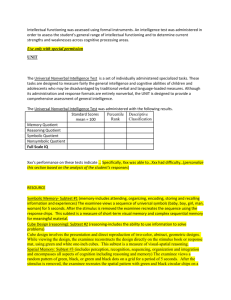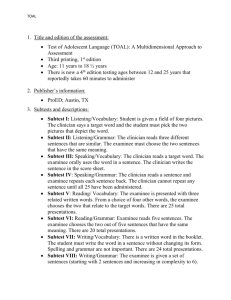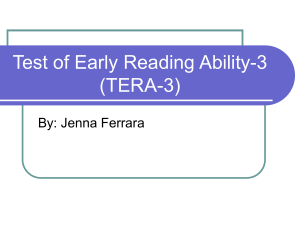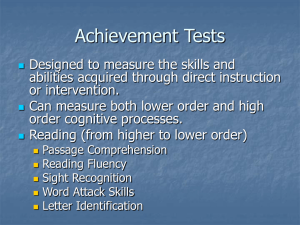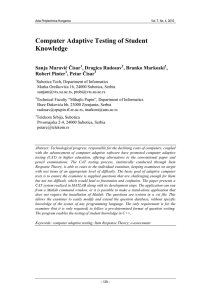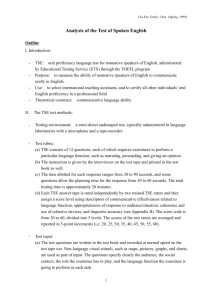Keymath handout
advertisement
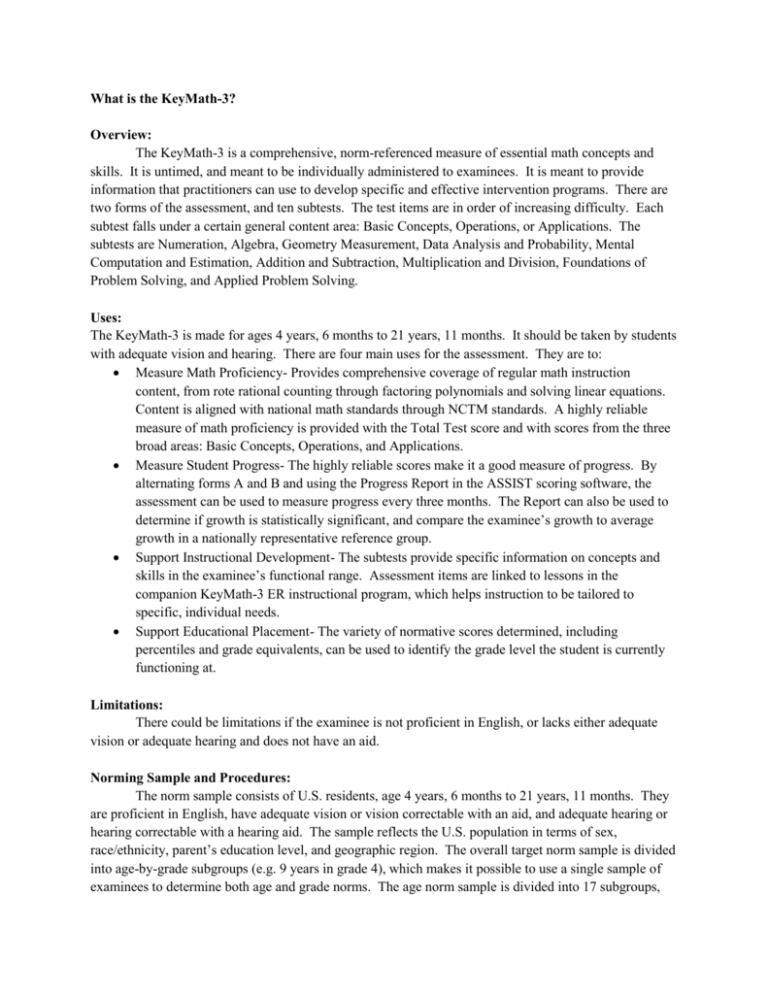
What is the KeyMath-3? Overview: The KeyMath-3 is a comprehensive, norm-referenced measure of essential math concepts and skills. It is untimed, and meant to be individually administered to examinees. It is meant to provide information that practitioners can use to develop specific and effective intervention programs. There are two forms of the assessment, and ten subtests. The test items are in order of increasing difficulty. Each subtest falls under a certain general content area: Basic Concepts, Operations, or Applications. The subtests are Numeration, Algebra, Geometry Measurement, Data Analysis and Probability, Mental Computation and Estimation, Addition and Subtraction, Multiplication and Division, Foundations of Problem Solving, and Applied Problem Solving. Uses: The KeyMath-3 is made for ages 4 years, 6 months to 21 years, 11 months. It should be taken by students with adequate vision and hearing. There are four main uses for the assessment. They are to: Measure Math Proficiency- Provides comprehensive coverage of regular math instruction content, from rote rational counting through factoring polynomials and solving linear equations. Content is aligned with national math standards through NCTM standards. A highly reliable measure of math proficiency is provided with the Total Test score and with scores from the three broad areas: Basic Concepts, Operations, and Applications. Measure Student Progress- The highly reliable scores make it a good measure of progress. By alternating forms A and B and using the Progress Report in the ASSIST scoring software, the assessment can be used to measure progress every three months. The Report can also be used to determine if growth is statistically significant, and compare the examinee’s growth to average growth in a nationally representative reference group. Support Instructional Development- The subtests provide specific information on concepts and skills in the examinee’s functional range. Assessment items are linked to lessons in the companion KeyMath-3 ER instructional program, which helps instruction to be tailored to specific, individual needs. Support Educational Placement- The variety of normative scores determined, including percentiles and grade equivalents, can be used to identify the grade level the student is currently functioning at. Limitations: There could be limitations if the examinee is not proficient in English, or lacks either adequate vision or adequate hearing and does not have an aid. Norming Sample and Procedures: The norm sample consists of U.S. residents, age 4 years, 6 months to 21 years, 11 months. They are proficient in English, have adequate vision or vision correctable with an aid, and adequate hearing or hearing correctable with a hearing aid. The sample reflects the U.S. population in terms of sex, race/ethnicity, parent’s education level, and geographic region. The overall target norm sample is divided into age-by-grade subgroups (e.g. 9 years in grade 4), which makes it possible to use a single sample of examinees to determine both age and grade norms. The age norm sample is divided into 17 subgroups, with approximately 220 individuals per group. There was a 6-month age interval for examinees 4 years, 6 months to 4 years, 11 months, a 1-year interval for examinees 5-19, and a 2-year interval for examinees 20-21. The grade norm sample (ages 5-18 and grades K-12) was divided into 26 subgroups. There were 110 individuals per grade assessed in the fall and spring. Administration and Scoring: Record examinee’s identifying information (name, grade, teacher, etc.) as prompted on the record form. Make sure to calculate the student’s chronological age and record it. Items are in order of increasing difficulty, and the start item is intended to be well within the ability of the examinee. The start item for the first subtest, Numeration, is determined by the student’s grade. The rest start based on the Numeration ceiling item. The basal rule is the three consecutive items correct preceding the first incorrect response. These items are the basal set, and the basal item is the first of these three. The ceiling rule is four consecutive incorrect items, which make up the ceiling set. The ceiling item is the highest of these four. Record the basal and ceiling on the record form. Use the test easels to administer the assessment. Find the appropriate start item, and prompt the examinee using the given script. If a student is not responding, you may give general encouragement. If the examinee gets an item correct, circle “1” on the record form. If incorrect, circle “0” on the form. If there are two parts to an item, both must be answered correctly in order to mark the item correct. Incomplete items are incorrect. Administer subtests with the appropriate start item and go until the ceiling is reached. Written computation subtests do not use an easel, but an examinee written response booklet. Give the examinee ample time to complete these items, but if they do not respond within about 30 seconds, give a prompt for a response. If there is no answer or attempt, mark the item incorrect and move on to the next item. Record examinee behavior during the assessment. There is a chart in the record form to record confidence, attention, conscientiousness, and effort, along with any other notes. Materials: The examiner needs a pen or pencil, a calculator, the two test easels, and a record form with examinee written response booklet. Scratch paper can be used only on the Applied Problem Solving subtest. Calculators may also only be used on the Applied Problem Solving subtest and only by examinees in third grade or higher. Subtest Overviews: Basic Concepts: Numeration- Measures examinee’s understanding of whole and rational numbers. It covers concepts from simple identification, comparing, and rounding to square roots, exponents, and scientific notation. Algebra- Measures pre-algebraic and algebraic concepts. It covers topics like sorting, classifying, recognizing patterns and functions, variables, equations, and representing mathematical relationships. Geometry- Measures ability to analyze, describe, and compare shapes. Covers topics like spatial relationships, coordinates, symmetry, lines, and angles. Measurement- Measures ability to compare objects and units. Covers topics like measuring angles, measuring distance and time, and working with money. Data Analysis and Probability- Measures ability to collect, display, and interpret data. It also covers chance and probability. Operations: Mental Computation and Estimation- Measures ability to mentally compute using addition, subtraction, multiplication, and division. Covers 1-, 2-, and 3-digit numbers, fractions, decimals, and percentages. Addition and Subtraction- Measures ability to add and subtract whole and rational numbers. It also covers simplifying algebraic expressions involving adding and subtracting. Multiplication and Division- Measures ability to multiply whole and rational numbers. It also covers simplifying algebraic expressions involving multiplying and dividing. Applications: Foundations of Problem Solving- Measures ability to identify elements, operations, and strategies for solving math problems. Applied Problem Solving- Measures ability to interpret problems in context and apply computational skills and conceptual knowledge. Test Interpretation -Needs an analysis of his/her derived scores (subtest scale scores, area, and total test standard scores, grade equivalents) but also an individually tailored comprehensive analysis of item content and examinee performance. -Derived Scores: Two types of normative scores: relative standing and developmental -Relative Standings: scale scores, standard scores and percentile ranks. -These indicate the position the test taker’s raw score is in relation to the distribution of scores for the grade. -Scale scores are for subtests. -Scale scores have a mean of 10 and an SD of 3 for each grade and age. -Standard Scores for the three content areas (Basic Concepts, Operations, and Application) and Total Test. -Score Profile: Facilitates the process of prioritizing instructions. It also supports an analysis of the severity of a performance deficit. To do so, the examiner would draw two vertical lines intersecting with end points of Total Test confidence interval. Lines on the right represent examinee’s strengths and lines to the left represent the examinee’s weaknesses. Examiners determine whether the Total Tests confidence interval overlaps the average standard score range (85-115). -Area Comparison: examiner should calculate the standard score difference for each of the three pairs of area standard scores and then compare each difference to the values indicating statistical significance. - Functional-Range: tend to generally consist of 8-10 items, depending on the item difficulties around a given raw score. This range comprises items that measure concepts and skills that the examinee is developing. The items the examinee answers incorrectly, show where instruction needs to occur. -Focus Items: an examinee is usually given items below, at, and above their functional range. When an examinee answers items below their functional range wrong, they call that focus items. Likewise, if an examinee answers items above their functional range, it should be evaluated, and praised. -Behavioral Observations During Testing Reliability There are three methods to check the reliability of the test. -Internal-Consistency Reliability: is a type of analysis that indicates consistency of performance across item sets. -Test-Retest: analysis measures the magnitude of such effects. -Alternate-Form Reliability: indicates the resistance of test scores to both of the sources of measurement error (different sets of items taken on different occasions). Validity KeyMath3 is a valid test, and has been compared to with multiple different tests to verify the validity. Every test that KeyMath3 was compared to come back with positive correlations between item content and scoring. Quality of KeyMath3 KeyMath3 is a quality test because it covers multiple different concept areas. These areas include, Basic Concepts, Operations, and Applications which all get scored. There is also a Total Test score that is involved in this test. KeyMath3 is a difficult test to score because of the multiple subtest scoring, and other tools that are used to interpret the test, such as the behavioral observations during the test, and score profile.
